人教版新课标英语九年级上Unit6教学设计
- 格式:doc
- 大小:55.50 KB
- 文档页数:5
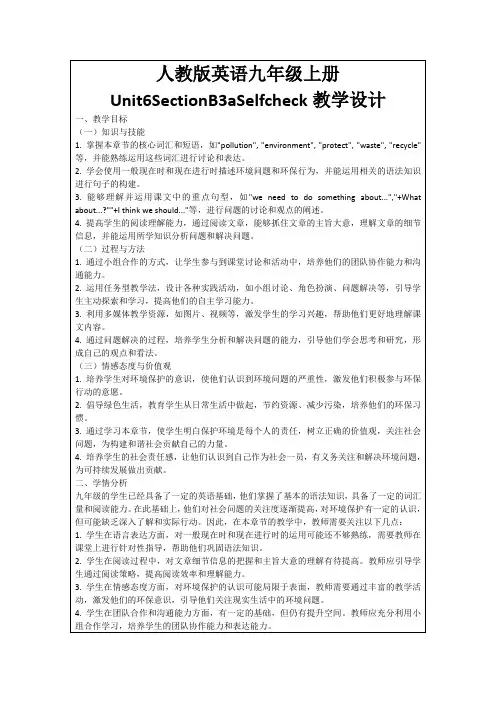
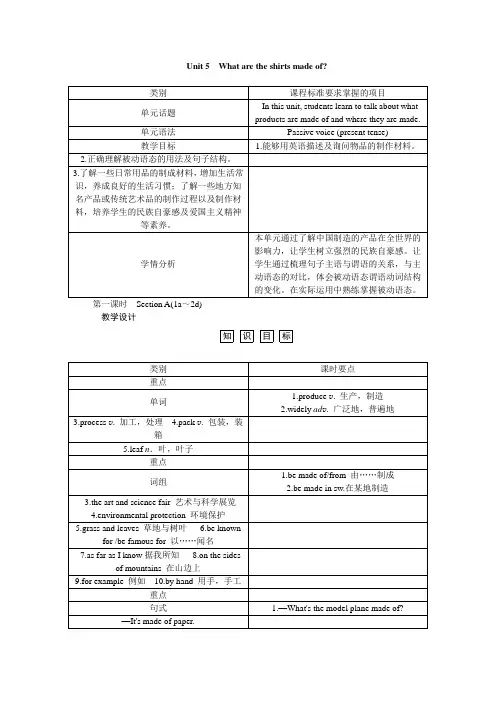
Unit 5What are the shirts made of?第一课时Section A(1a~2d)教学设计知识目标课堂环节§自主学习案翻译下列词组。
1.由……做成be__made__of/be__made__from2.在某地制造be__made__in__3.艺术和科学展览the__art__and__science__fair4.飞机模型a__model__plane5.因……出名be__famous__for/be__known__for6.在山边上on__the__sides__of__mountains7.手工制作by__hand8.世界各地all__over__the__world9.对……有好处be__good__for10.在过去in__the__past11.据我所知as__far__as__I__know§课堂导学案Step 1 准备与热身(Preparation)播放动画片《造纸过程》的视频,让学生们了解这个中国传统发明的情况。
T: Who invented paper first?S1:Cai Lun invented it in Han Dynasty.T: What was paper made of then?S2: It was mainly made of bamboo.T: Was it easy for people to make paper then?S1:No, it was very difficult then.T: What is paper made of now?S3: It's mainly made of wood, bamboo, and cotton.…Step 2 呈现与输入(Presentation)1.要求学生翻开课本P33页,快速阅读1a表格部分的内容。
把物品和可能构成他们的材料匹配起来。
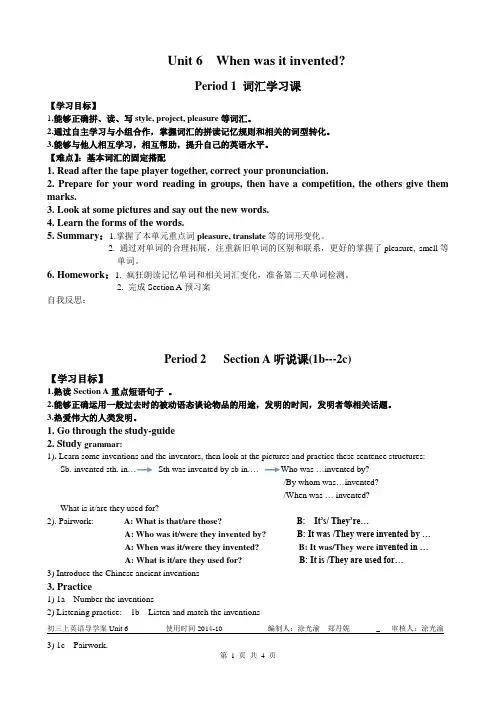
Unit 6 When was it invented?Period 1 词汇学习课【学习目标】1.能够正确拼、读、写style, project, pleasure等词汇。
2.通过自主学习与小组合作,掌握词汇的拼读记忆规则和相关的词型转化。
3.能够与他人相互学习,相互帮助,提升自己的英语水平。
【难点】:基本词汇的固定搭配1. Read after the tape player together, correct your pronunciation.2. Prepare for your word reading in groups, then have a competition, the others give them marks.3. Look at some pictures and say out the new words.4. Learn the forms of the words.5. Summary:1.掌握了本单元重点词pleasure, translate等的词形变化。
2. 通过对单词的合理拓展,注重新旧单词的区别和联系,更好的掌握了pleasure, smell等单词。
6. Homework:1. 疯狂朗读记忆单词和相关词汇变化,准备第二天单词检测。
2. 完成Section A预习案自我反思:Period 2 Section A听说课(1b---2c)【学习目标】1.熟读Section A重点短语句子。
2.能够正确运用一般过去时的被动语态谈论物品的用途,发明的时间,发明者等相关话题。
3.热爱伟大的人类发明。
1. Go through the study-guide2. Study grammar:1). Learn some inventions and the inventors, then look at the pictures and practice these sentence structures:Sb. invented sth. in…Sth was invented by sb in.…Who was …invented by?/By whom was…invented?/When was … invented?What is it/are they used for?2). Pairwork: A: What is that/are those? B: It’s/ They’re…A: Who was it/were they invented by? B: It was /They were invented by …A: When was it/were they invented? B: It was/They were i nvented in …A: What is it/are they used for? B: It is /They are used for…3) Introduce the Chinese ancient inventions3. Practice1) 1a Number the inventions2) Listening practice: 1b Listen and match the inventions初三上英语导学案Unit 6 使用时间2014-10编制人:涂光渝郑丹妮 _ 审核人:涂光渝3) 1c Pairwork.4) 2a Listen.Listen and number the inventions2b Listen again and complete the chart.5)2c PairworkA: What are they used for…?B: They’re used for…4. Summary: 通过对话和听力练习熟练掌握了一般过去时被动语态的句子结构及本单元句型:What’s it used for?When was it invented?Who was it invented by?5. Homework:1. 完成新支点的第一课时。
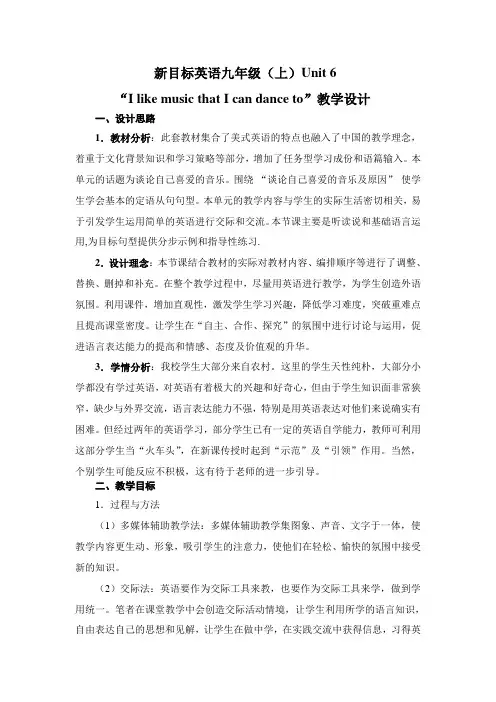
新目标英语九年级(上)Unit 6“I like music that I can dance to”教学设计一、设计思路1.教材分析:此套教材集合了美式英语的特点也融入了中国的教学理念,着重于文化背景知识和学习策略等部分,增加了任务型学习成份和语篇输入。
本单元的话题为谈论自己喜爱的音乐。
围绕“谈论自己喜爱的音乐及原因”使学生学会基本的定语从句句型。
本单元的教学内容与学生的实际生活密切相关,易于引发学生运用简单的英语进行交际和交流。
本节课主要是听读说和基础语言运用,为目标句型提供分步示例和指导性练习.2.设计理念:本节课结合教材的实际对教材内容、编排顺序等进行了调整、替换、删掉和补充。
在整个教学过程中,尽量用英语进行教学,为学生创造外语氛围。
利用课件,增加直观性,激发学生学习兴趣,降低学习难度,突破重难点且提高课堂密度。
让学生在“自主、合作、探究”的氛围中进行讨论与运用,促进语言表达能力的提高和情感、态度及价值观的升华。
3.学情分析:我校学生大部分来自农村。
这里的学生天性纯朴,大部分小学都没有学过英语,对英语有着极大的兴趣和好奇心,但由于学生知识面非常狭窄,缺少与外界交流,语言表达能力不强,特别是用英语表达对他们来说确实有困难。
但经过两年的英语学习,部分学生已有一定的英语自学能力,教师可利用这部分学生当“火车头”,在新课传授时起到“示范”及“引领”作用。
当然,个别学生可能反应不积极,这有待于老师的进一步引导。
二、教学目标1.过程与方法(1)多媒体辅助教学法:多媒体辅助教学集图象、声音、文字于一体,使教学内容更生动、形象,吸引学生的注意力,使他们在轻松、愉快的氛围中接受新的知识。
(2)交际法:英语要作为交际工具来教,也要作为交际工具来学,做到学用统一。
笔者在课堂教学中会创造交际活动情境,让学生利用所学的语言知识,自由表达自己的思想和见解,让学生在做中学,在实践交流中获得信息,习得英语。
(3)坚持以学生为中心,采用individual work和pair work相结合的活动方式使学生进行自主学习、合作探究、体验实践及展示自我,发展听、说、读、写等综合语言运用技能。
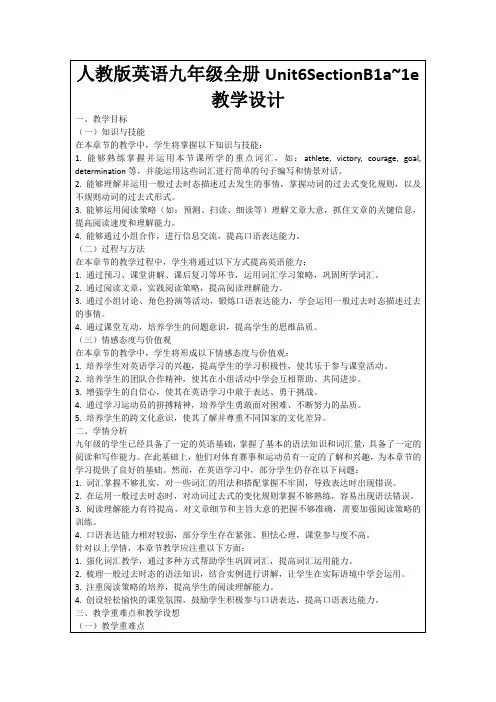
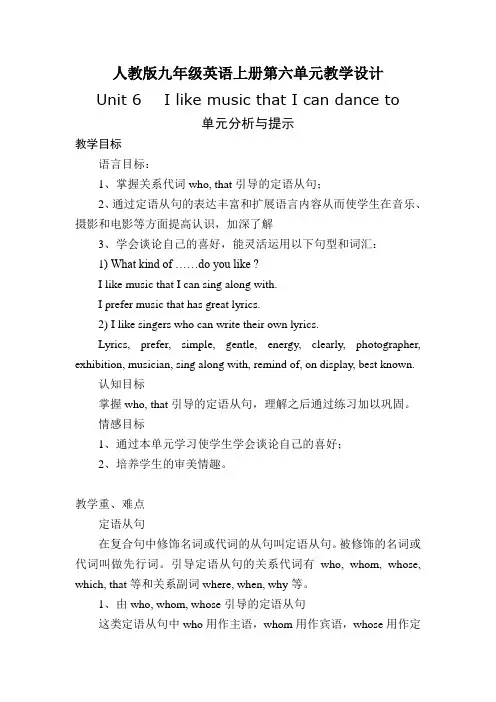
人教版九年级英语上册第六单元教学设计Unit 6 I like music that I can dance to单元分析与提示教学目标语言目标:1、掌握关系代词who, that引导的定语从句;2、通过定语从句的表达丰富和扩展语言内容从而使学生在音乐、摄影和电影等方面提高认识,加深了解3、学会谈论自己的喜好,能灵活运用以下句型和词汇:1) What kind of ……do you like ?I like music that I can sing along with.I prefer music that has great lyrics.2) I like singers who can write their own lyrics.Lyrics, prefer, simple, gentle, energy, clearly, photographer, exhibition, musician, sing along with, remind of, on display, best known.认知目标掌握who, that引导的定语从句,理解之后通过练习加以巩固。
情感目标1、通过本单元学习使学生学会谈论自己的喜好;2、培养学生的审美情趣。
教学重、难点定语从句在复合句中修饰名词或代词的从句叫定语从句。
被修饰的名词或代词叫做先行词。
引导定语从句的关系代词有who, whom, whose, which, that等和关系副词where, when, why等。
1、由who, whom, whose引导的定语从句这类定语从句中who用作主语,whom用作宾语,whose用作定语。
This is the man who helped me.The doctor whom you are looking for is in the room.Do you know the man whose name is Wang Yu?2、由which引导的定语从句which在从句中作主语或谓语动词和介词的宾语。
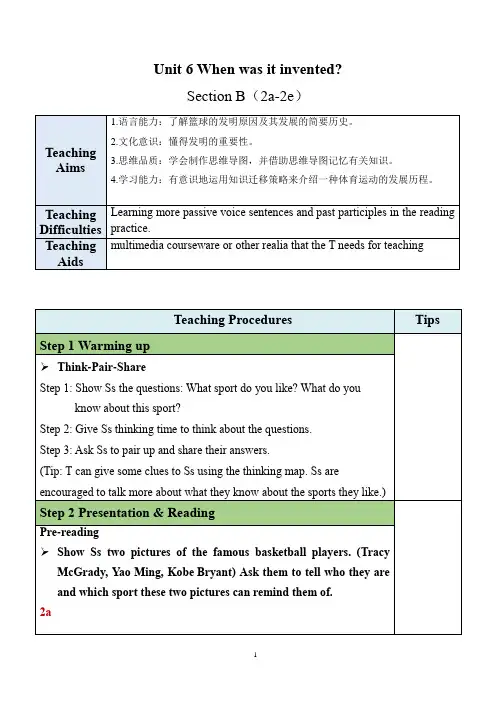
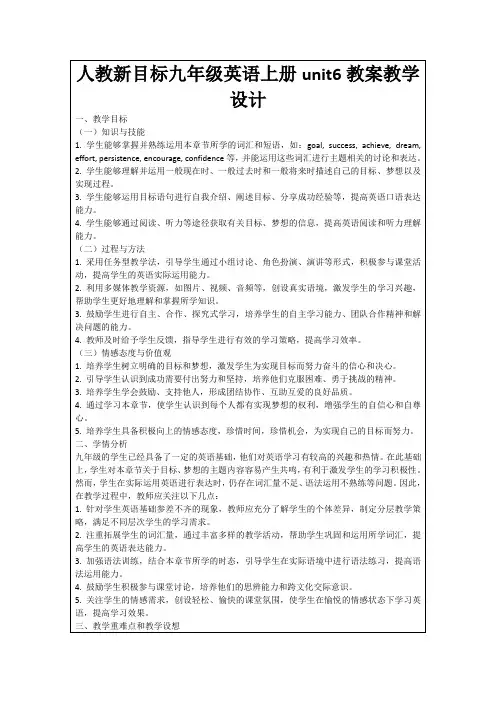
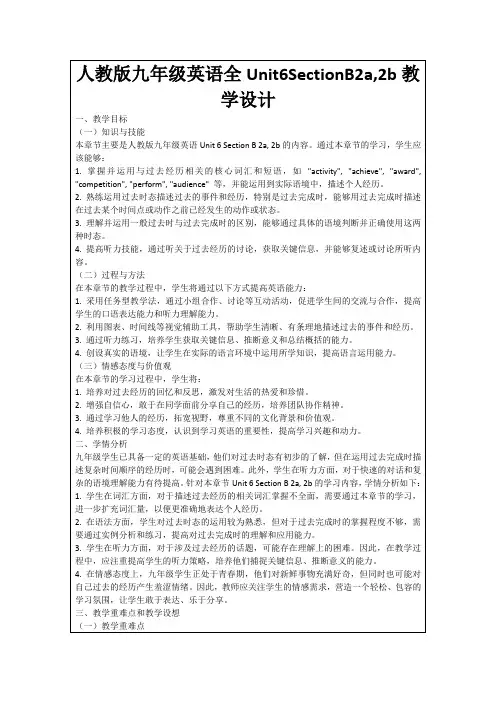
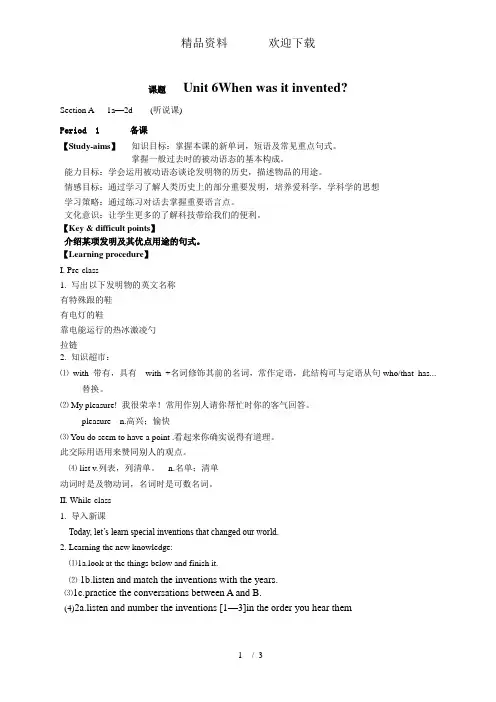
课题 Unit 6When was it invented?Section A 1a —2d (听说课)Period 1备课 知识目标:掌握本课的新单词,短语及常见重点句式。
掌握一般过去时的被动语态的基本构成。
能力目标:学会运用被动语态谈论发明物的历史,描述物品的用途。
文化意识:让学生更多的了解科技带给我们的便利。
【Key & difficult points 】介绍某项发明及其优点用途的句式。
【Learning procedure 】2. 知识超市:⑴ with 带有,具有 with +名词修饰其前的名词,常作定语,此结构可与定语从句who/that has...替换。
⑵ My pleasure! 我很荣幸!常用作别人请你帮忙时你的客气回答。
pleasure n.高兴;愉快⑶ You do seem to have a point .看起来你确实说得有道理。
此交际用语用来赞同别人的观点。
⑷ list v.列表,列清单。
n.名单;清单动词时是及物动词,名词时是可数名词。
II. While-class1. 导入新课Today, let’s learn special inventions that changed our world.2. Learning the new knowledge:⑴1a.look at the things below and finish it.⑵ 1b.listen and match the inventions with the years.⑶1c.practice the conversations between A and B.(4)2a.listen and number the inventions [1—3]in the order you hear them【Study-aims 】 情感目标:通过学习了解人类历史上的部分重要发明,培养爱科学,学科学的思想学习策略:通过练习对话去掌握重要语言点。
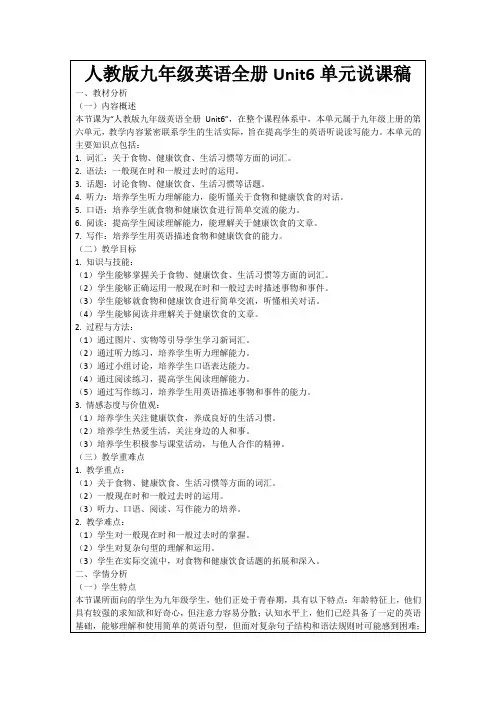
Unit 6 Section A-1Class Type Listening, reading and speakingObjectives 1.To know the order of the invented things.2.To learn the year of the invented things by listening.3.To practice talking about the inventions in the pictures.Key structure 1. When was the telephone invented?—I think it was invented in 1876.2. What are they used for?—They are used for …3. Can you help me think of an invention? —My pleasure.4. You do seem to have a point.Difficulties How to understand the information of those inventions.Vocabulary Style, project, pleasure, daily, website, pioneer, list, mentionbe used for, seem to, have a pointPeriod 1ProcedureLead-in Free talk.Show Ss some pictures about inventions and ask Ss to talkabout more information of these inventions.Step 1 Enjoy a flash.Step 2 Activity 1b.Let Ss listen to the tape and match the inventions with theproper dates.Step 3 Listen again and answer the questions with the properinformation from 1b.Step 4 Discussion.Show Ss some pictures and ask them to make sentencesbased on the information from the pictures.Step 5 Pair works.Show Ss some pictures about the inventions and ask Ssmake a similar conversation with their partners by using the1b as a model.A: when was the telephone invented?B: I think it was invented in 1876.…Step 6 Activity 2a.Listen and number the inventions in the order you hear. Step 7 Activity 2b-1.Let Ss listen again and then match the inventions with theirinventors and users.Step 8 Activity 2b-2.Listen again and answer some questions.Step 9 Pair works.Let Ss make conversations in groups by using theinformation in 2b.e.g. :A: What are they used for?B: They’re used for seeing in the dark.Step 10 Brainstorm.Show Ss some pictures about cool inventions.Step 11 Activity 2d.Let Ss read the conversation and answer the questions. Step 12 Brainstorm.Introduce Ss about the person Whitcomb L. Judson.Step 13 Let Ss listen again with reading after the tape.Step 14 Pair works.Show Ss some pictures about the inventions and ask Ss totalk about the familiar ones with their partners.Step 15 Brainstorm.Introduce Ss the 10 most important inventions throughouthistory.Step 16 Language points: explain the key words and phrases in section A-1.。
新课标九年级英语unit6教学设计Unit6 Reading He used to cause a lot of trouble.一Teaching Aims and Demands1. Knowledge Objects(1).70% of the students can read and write the key vocabulary: death, afford, cause, himself, patient, in the end, decision, make a decisi on, head teacher, necessary, to one’s surprise, exactly, even though, no longer, take pride in, pay attention to, give up, waste, not…any more(2). Key structures:通过本节课的学习,熟练运用used to 结构.His mother couldn’t afford to pay for her child’s education..Even though my father was no longer with us, he was watching me, and would always take pride in everything good I do.2. Ability ObjectsTo train students’ reading ability.3.Emotion and attitude goals:Get the students to know their shortcomings in the past. Encourage the students to make themselves more perfect in their life and study in the future.二、重难点:1、理解短文内容,正确处理有关的信息。
第6单元第1课主备人:审核人:第1课时课型新授课课题When was it invented?课时总5课时授课人刘娜主备教师设计思路授课教师二次备课教学目标:1. 学生能够了解各项发明的具体时间并排序;2. 学生能够用be invented, be used for等结构表达某项发明的信息;3. 学生能够在交流中熟练运用一些口头表达常用句型;4. 学生能够感受到科技发明对生活产生的影响并举例说明。
教学重点:用be invented, be used for等结构表达发明信息。
教学难点:举例说明科技带来的影响。
教学方法:“ARE”教学模式下的自主学习→合作探究→启发式教学课前自学自学活动:1. 知识链接:搜集影响力较大的事物(如中国的四大发明或电视机、电脑等)的发明信息,了解其发明者及时间等。
2. 教材自学:(1)预习本课所涉及的单词及短语,完成学案上的词汇检测;(2)自主阅读2d,标出不太理解的句子,多读几遍,直到把课文读得准确、流利。
自学质疑:学生自学后有什么问题或疑问,提出来当堂解决。
我的困难(或问题)是:。
课上研学一、自学反馈学生以小组形式讨论课前自学中遇到的困难或疑问,如有组内无法解决的,则进行全班讨论。
老师将在导入环节对学生的课前自学进行检测。
二、聚焦问题1. 学生完成听力练习后,根据所知信息进行句型操练,如:—When was the telephone invented?—I think it was invented in 1876.—What are they used for?—They are used for …2. 学生读完2d之后回答以下问题:(1)What invention are they talking about?(2)Do they think it a great invention? Why?三、研究分享合作探究、小组分享:学生小组讨论,确定一个对生活产生巨大影响的发明并阐述其重要影响。
Go for it!新目标英语九年级(上)
Unit 6 I like music that I can dance to
SectionA 1a-1c
教学设计
一、教学目标
1.知识与技能
(1)使全体学生掌握本节课的重点词汇和基本了解that 引导的定语从句;
(2)使学生能用本节课的重点词汇和句型简单的对话;
(3)使学生能充分运用本节课的重点词汇和句型表达自己的观点,并能灵活运用英语进行听、说、读、写等活动。
2.过程与方法
(1)多媒体辅助教学法:多媒体辅助教学集图象、声音、文字于一体,使教学内容更生动、形象,吸引学生的注意力,使他们在轻松、愉快的氛围中接受新的知识。
(2)交际法:英语要作为交际工具来教,也要作为交际工具来学,做到学用统一。
笔者在课堂教学中会创造交际活动情境,让学生利用所学的语言知识,自由表达自己的思想和见解,让学生在做中学,在实践交流中获得信息,习得英语。
(3)坚持以学生为中心,采用individual work和pair work相结合的活动方式使学生进行自主学习、合作探究、体验实践及展示自我,发展听、说、读、写等综合语言运用技能。
(4)充分运用任务型语言教学法指导本节课,以任务环贯穿教学主线,培养学生学会用语言做事的能力。
(5)建立融洽、民主的师生、生生交流渠道,与学生一起反思学习过程和学习效果,不断进行自我评价进而调整改进学习目标与学习策略。
3.情感、态度与价值观
(1)通过欣赏不同类型的音乐,不断提高学生的文化素养,同时帮助他们树立乐观、开朗的人生观;
(2)在操练语言、归纳总结和共同完成话题任务的过程中,加强团体协作
意识。
二、教学重点
(1)重点词汇:prefer, lyric, gentle ,musician, have great lyrics, sing along with, dance to, different kinds of music, quiet and gentle songs, write one’s own music.
(2)重点句型:What kind of music do you like?
I like music that I can sing along with.
I prefer music that has great lyrics.
I love musicians who write their own music.
三、教学难点
(1)that 引导的定语从句
(2)培养学生有效进行语言输入和语言输出转换的能力。
(3)在训练学生语言能力的同时,注重激发学生的想象能力,培养学生的创新思维,提升他们的整体素质。
四、教学过程
Step 1. Warming-up and lead in
(1). The teacher introduces herself by playing and singing some songs .
T: Do I sing well? So do you like music? What kind of music do you like?
(2).Show some music that students have gotten from the internet and ask :
T: Do you know this piece of song? Ss: Yes.
T: What’s the song? Ss: Sound of music
T: I like this song because it’s a song that I can dance to.
Ask a student “ do you like this song ?”S: Yes.
T: Why? (Try to help him to answer “ It’s a song that I can dance to ) (3)The teacher dance to the music in front of the class and ask some students to learn
(4) Read this sentence and ask students to repeat. Pay attention to the praises dance to .
(5) Use the same method to show out the important praises and sentences.
设计意图:首先教师先以唱歌的形式介绍自己,可以拉近和学生的距离,感
觉很亲切。
其次,教师先以直观图片和音乐创设话题情景,借助层层递进的教学活动,逐步的导出本节课的重点词汇和句型,引导学生逐步进入更深层次的学习境界。
S tep 2. Pairwork
Ask a student to make conversation with the teacher
Ask students to make the similar conversation with their partner using the helpful praises.
设计意图:教师请几个好的同学作榜样示范。
让大多数学生有一个从观察、聆听、模仿再到自主表述的准备过程,减少学生内心的焦虑,促使他们积极主动,生动活泼地学习。
Step3 1a
Show the pictures and the sentence of 1a . Read the sentences and ask students to repeat.
Step 4 Listening practice
(1)Ask students to listen to the tape and finish 1b
(2)Check the answers
(3)Show the listening passage and ask students to listen to the tape again
and repeat
设计意图:通过听力练习,培养学生养成正确的听力习惯,训练学生听音获取处理和使用信息的能力。
简单有效的听、说、读训练,发展语言技能,提高学生运用英语的能力。
Step 5 Ask and answer
A:What kind of music does Tony like?
B:He likes music that has great lyrics.What about Betty?
A:She prefers music that she can sing along with.
Step 6Make conversations in groups
A:What kind of music do you like?
B:I like music that….
What about you?
A:I prefer music that …
C:What kind of music does…like?
D:He/She likes music that….
What about …?
C:He/She prefers music that….
设计意图:通过听力训练引出第三人称,小组训练第三人称转述,提高学生运用定语从句的能力。
Step 7Make a survey
Step 8 Summary
在复合句中修饰名词或代词的从句叫定语从句
e.g. I like music that I can dance to.
Music 是先行词,that是关系代词
Step9 Homework
Write down Attributive Clause sentences about music as many as you can .
设计意图:课外作业是课堂教学的延续、深化和补充。
以作业的形式,将学习任务延伸到课外,训练学生自主学习能力。
板书设计。